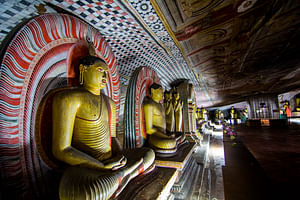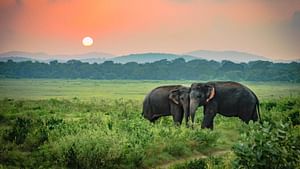Spend a few overnights in Cultural Triangle in Sri Lanka and search and visit for the home of ancient Sinhalese royalty is loaded with ancient ruins and restored temples, a must-visit when in Sri Lanka, such as Anuradhapura, Polonnaruwa, Sigiriya, Dambulla, and Kandy.
Duration
The tour starts at
-
Day 1
Colombo to Kandy
Colombo to Kandy
-
Day 1
Straight. Surrounded by mountains, which are home to tea plantations and biodiverse rainforest. The city's heart is scenic Kandy Lake which is popular for strolling. Kandy is famous for sacred Buddhis...
Straight. Surrounded by mountains, which are home to tea plantations and biodiverse rainforest. The city's heart is scenic Kandy Lake which is popular for strolling. Kandy is famous for sacred Buddhist sites, including the Temple of the Tooth (Sri Dalada Maligawa) shrine, celebrated with the grand Esala Perahera annual procession. This was the last capital of the Sinhala kings whose patronage enabled the Dinahala culture to flourish for more than 2,500 years until the occupation of Sri Lanka by the British in 1815. It is also the site of the Temple of the Tooth Relic (the sacred tooth of the Buddha), which is a famous pilgrimage site, one of the most famous Buddhist temples in the world, which was built to protect the sacred tooth relic thought to belong to Lord Buddha, which has been enshrined in Sri Lanka for hundreds of years.
-
Day 2
Kandy to Anuradhapura/Polonnaruwa
Kandy to Anuradhapura/Polonnaruwa
-
Day 2
.Anuradhapura is one of the ancient capitals of Sri Lanka, famous for its well-preserved ruins of ancient Lankan civilization. From the 4th century BC, it was the capital of Sri Lanka until the beginn...
.Anuradhapura is one of the ancient capitals of Sri Lanka, famous for its well-preserved ruins of ancient Lankan civilization. From the 4th century BC, it was the capital of Sri Lanka until the beginning of the 11th century AD. During this period it remained one of the most stable and durable centers of political power and urban life in South Asia. The ancient city, considered sacred to the Buddhist world, is today surrounded by monasteries covering an area of over sixteen square miles. Anuradhapura is also significant in Hindu legend as the fabled capital of the Asura King Ravana in the Ramayana.
-
Day 2
Another UNESCO world heritage site, according to the chronicles, during the 12th century a prince of great metal and physical vigour hailing from the Rohana (Southern part of Sri Lanka) forced his way...
Another UNESCO world heritage site, according to the chronicles, during the 12th century a prince of great metal and physical vigour hailing from the Rohana (Southern part of Sri Lanka) forced his way to the throne of Sri Lanka as King Prakrama Bahu the great. Establishing himself in Polonnaruwa, a capital worthy of authority and ambition of the ruler, he proceeded to show himself as a successful warrior and a great administrator, during which time he, through a medium of a dam nine miles long created the Sea of Parakrama” harvesting rain water to be used in the dry period of the year for cultivation purposes, carving the irrigation brilliance of Sri Lankan’s in stone, when most of Europe where still in darkness. In a period of prosperity with the objective of storing food many such projects were undertaken some of which function even today. Today vast ruins stand sentinel bearing witness in Polonnaruwa to his power and glory.
-
Day 3
Sigiriya/Kandy
Sigiriya/Kandy
-
Day 3
Sigiriya was designated a UNESCO World Heritage site in 1982. The rock, which is so steep that its top overhangs the sides, rises to an elevation of 1,144 feet above sea level and is some 600 feet abo...
Sigiriya was designated a UNESCO World Heritage site in 1982. The rock, which is so steep that its top overhangs the sides, rises to an elevation of 1,144 feet above sea level and is some 600 feet above the surrounding plain. The Sinhalese king Kashyapa built a palace in the shape of a monumental lion on the several acres of ground at the summit, intending it to be a safeguard against his enemies. However, the king was defeated in 495, and the palace fell into ruin. The site soon became a pilgrimage destination, however, and it is now a popular tourist spot. Visitors begin the final ascent to the top through the open paws of the lion, one of the few remaining portions of the palace that are still intact. A person who goes to Sigiriya Lion Rock after 8’clock has to undergo a lot of noise, and is waiting in the queue. This is why we as an experienced tour company, organize the Sigiriya day excursion early to enjoy without any problems.
-
Day 3
Dambulla cave temple also known as the Golden Temple of Dambulla is a World Heritage Site(1991) in Sri Lanka, situated in the central part of the country. It is the largest and best-preserved cave tem...
Dambulla cave temple also known as the Golden Temple of Dambulla is a World Heritage Site(1991) in Sri Lanka, situated in the central part of the country. It is the largest and best-preserved cave temple complex in Sri Lanka. The rock towers 160 m over the surrounding plains.There are more than 80 documented caves in the surrounding area. Major attractions are spread over 5 caves, which contain statues and paintings,
-
Day 4
Kandy (Three Temple Tour)
Kandy (Three Temple Tour)
-
Day 4
One of the most legendary attractions in gampola , the Embekke, Lankatilaka and Galadeniya are a short distance from each other and sometimes referred to as the three-temple loop. The temples serve as...
One of the most legendary attractions in gampola , the Embekke, Lankatilaka and Galadeniya are a short distance from each other and sometimes referred to as the three-temple loop. The temples serve as a living testimony to Sri Lanka’s Buddhist heritage, Embekke temple was built by King Vikramabahu III to honour King Mahasena who ruled Sri Lanka from 277 to 304 AD. The Devalaya (temple) has three main areas; the Sanctum of Garagha, Dancing Hall and the Drummers Hall which is beautifully decorated with splendid wood sculptures and carvings of dragons and fierce battles between lions and elephants. Lankatilaka Vihara (monastery), the best example of architecture during the reign of King Buwanekabahu IV who made Gampola the capital of Sri Lanka during the mid-fourteenth century. Built on natural rock, the temple mixes stone, plaster and wood within its uniquely Sinhalese architectural style and is home to many ancient paintings which draw people from afar.
Breakfast
Air-conditioned vehicle
Professional English Guide Service
Govenment Service charges and tax












